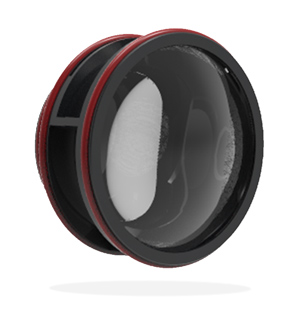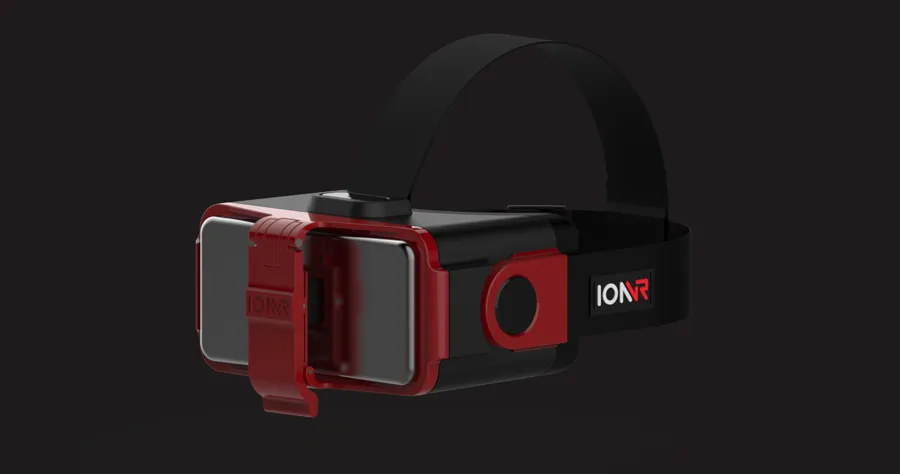If you haven’t heard of the IonVR yet, nobody would blame you. On outward appearance the Idaho-based company’s headset seems like nothing too special, a set of lenses with a place to strap in your phone, but it is what is inside that makes it so special. IonVR utilizes a proprietary, patent pending, technology the company is calling “MotionSync” which helps to make the experience much more comfortable than any other universal mobile VR viewer.

“MotionSync Technology,” says Brooke Linville IonVR’s CEO, “removes the distortion rendering from the mobile device and moves it into the headset,” resulting in a clear and comfortable experience that also isn’t eating away your phone’s battery life. The company is fairly muted currently about their internal technology, due to its patent pending status, but Linville told us “the system is a combination of optics and on-board processing.” Pressing for further details we were able to learn that there is at least an accelerometer and a processor inside the headset itself.
Interestingly, the hardware inside the headset does not communicate with the phone on any level. Rather it operates separately (powered by a pair of AAA batteries) to correct for motion blur and other things, meaning that it doesn’t provide drain on the phone’s battery life. According to the company, a phone running VR in their headset can last “twice, possibly three times as long” as the GearVR.

Trying it out for myself using, ironically, a Samsung Galaxy S6, I found the experience to be relatively comparable to that of the GearVR, minus some needs for ergonomic refinement on the 3D printed prototype I was using. The images were crystal clear thanks to IonVR’s proprietary optics system, which claims produces “less than 5% distortion,” which seemed fairly accurate. During the testing I didn’t see any smearing or chromatic aberration and the MotionSync technology worked pretty much as advertised, with very little motion blur or noticeable latency even with rapid head movements. Overall, the GearVR seems to perform slightly better than IonVR, but the gap is nowhere near as wide as it is between the GearVR and Google Cardboard.
Besides competitive hardware, IonVR is making some fairly big name partnerships in Hollywood. This past week the company announced a partnership with the Robert Stromberg-led Virtual Reality Company (VRC).
Sources tell us that the legendary director Steven Spielberg, who is also an advisor to the VRC, has a close relationship with the company that may extend beyond the advisory role. Spielberg’s name is beginning to crop up around VR a lot more lately. He is directing Ready Player One, which is already set to come out with a VR tie in experience of some sort. His and Stromberg’s tie to IonVR gives it a potentially significant advantage in Hollywood, which is heating up around VR.
With the internal hardware necessary for basic, head tracked VR, support for all phones 4.6″-6″ (including the iPhone), and a Hollywood team behind them, IonVR seems set to compete with the GearVR for the mobile VR market… at least for now.
The IonVR headset is set to ship sometime in spring 2016, with preorders available now for $229.
Full Specs:
HEADSET
-
Weight: 12 ounces
-
Dimensions: 7.3 in x 5.5 in x 3.6 in
OPTICS
-
Less than 5% distortion
-
Less than 100 microns lateral color
-
Works with Super Amoled and IPS displays
-
Adjustable IPD
DISPLAY
-
Field of View: Varies by phone and screen size, 80-100 degrees
-
Eye Relief: 15 mm eye relief for glasses
SMARTPHONE REQUIREMENTS
-
Screen size: 4.6″-6″
-
Resolution: Min. 720p resolution, 1080p recommended, 2k ideal
-
Operating System: iOS, Android, Windows
-
Phone must have an accelerometer
SUPPORTED SDKS
-
Google Cardboard
-
Drovious Dive
-
Project Tango
-
Contact us if you’d like to learn more about how our headset can work with your SDK.
POWER REQUIREMENTS
-
Batteries: 2 AAA Batteries (Lithium recommended for weight)
-
Battery Life: Over 300 hours of continuous use




























